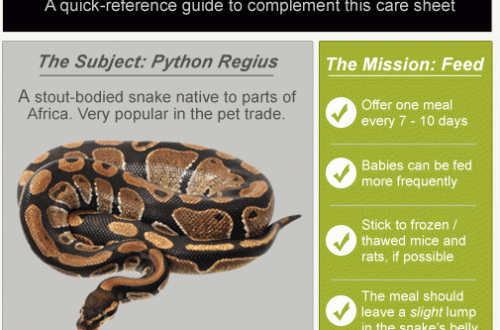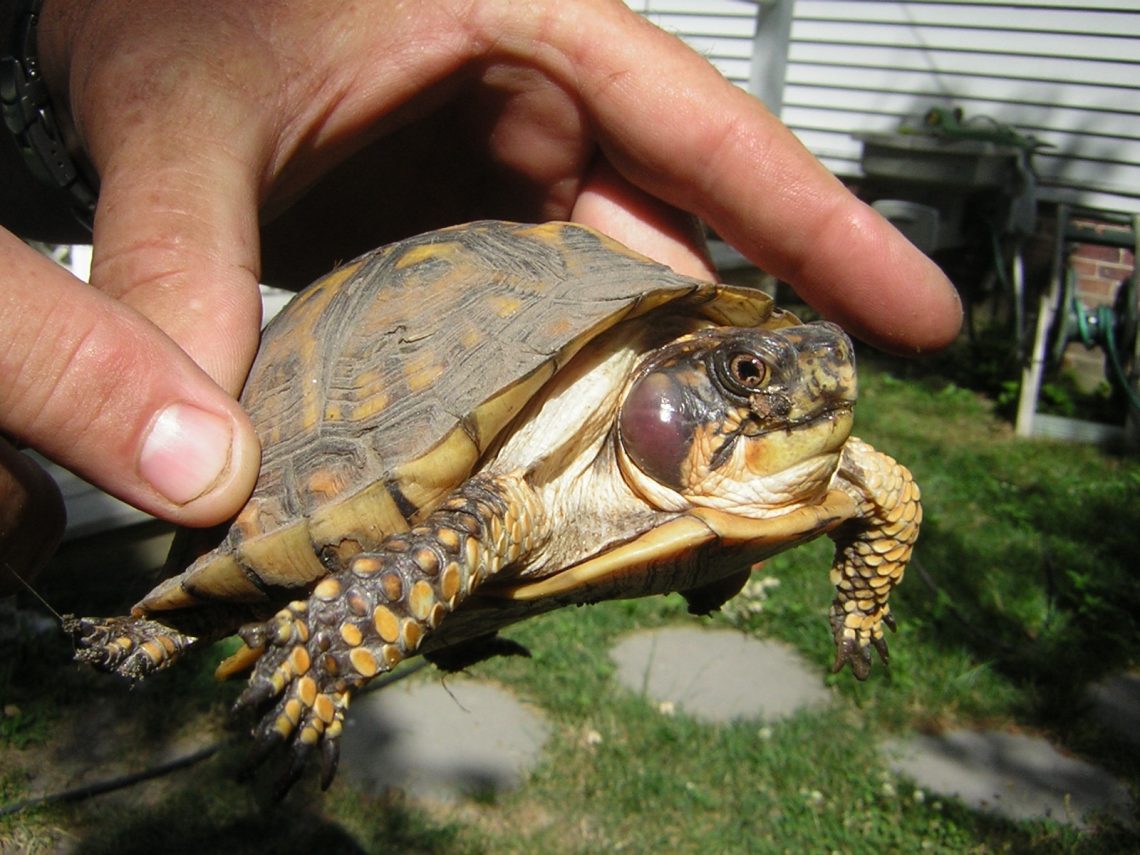
Mycotic dermatitis, fungus, saprolegniosis and bact. infection in aquatic turtles
Symptoms: excessive shedding, reddening of the skin, white “pimples” on the skin, ulcers, crumbling of the carapace, improper detachment of the scutes Turtles: water turtles Treatment: veterinary examination required
Fungal infections, including primary ones, are not uncommon in turtles. More often, however, mycoses develop secondary to a bacterial or viral infection and are associated with certain predisposing factors: stress, poor hygiene conditions, low temperatures, long courses of antibacterial drugs, improper feeding, non-compliance with the humidity regime, etc. superficial mycoses (mycotic dermatitis of the skin and shell). Deep (systemic) mycoses are a rarer phenomenon, although such cases may simply be less common. Most often, deep mycosis in turtles manifests itself in the form of pneumonia, enteritis or necrohepatitis and is clinically poorly differentiated from the same diseases of bacterial etiology. Rare types of mycoses of turtles are capable of causing mycoses in humans. Therefore, care should be taken when working with sick animals.
The disease is contagious to other turtles. A sick turtle should be isolated and placed in quarantine.
Aquatic turtles rarely show fungus, most often it is a bacterial infection, for example, streptococci infect the shell, rod-shaped bacteria infect the skin.
Turtles have the following types of mycobiota: Aspergillus spp., Candida spp., Fusarium incornatum, Mucor sp., Penicillium spp., Paecilomyces lilacinus.
THERAPY OF MAIN MYCOSES
Aspergillus spp. — Clotrimazole, Ketoconazole, +- Itraconazole, +- Voriconazole CANV – + – Amphotericin B, Nystatin, Clotrimazole, + – Ketoconazole, + – Voriconazole Fusarium spp. — +- Clotrimazole, +- Ketoconazole, Voriconazole Candida spp. — Nystatin, + — Fluconazole, Ketoconazole, + — Itraconazole, + — Voriconazole
The reasons:
Mycoses of the skin and shell occur as a result of the loss of resistance of the animal organism due to improper maintenance, parasites and, above all, bacteria. Infection is most often secondary to bacterial infection. Aquatic turtles get sick if they do not have the opportunity to dry and warm up on land for a long time, or if they themselves do not go to warm themselves, because. the water is too warm (more than 26 C). Sick turtles can generally stop visiting the reservoir – this is a kind of “self-treatment”. For example, in an aquarium 28 C, bright light and ultraviolet, ammonia in the water – all this can cause bacterial diseases of the skin and shell. Lamps should shine only on the island, and the water temperature should be a maximum of 25 C. It is advisable to use an external filter and do regular water changes. Aquatic turtles, which are released to walk on the floor, are often attacked by various infections, because. their skin on the floor dries out and microcracks form.
Symptoms: 1. Peeling and exfoliation of the skin. The most commonly affected areas are the neck, limbs, and tail, especially where the skin folds. In the water, the turtle looks like it is covered with a thin cobweb coating (in the case of saprolegniosis), or with whitish films resembling a molt. This is not a fungus or bacterial infection, but simply a molting disorder. Give the turtle a chance to warm up, feed a variety of foods, and use a soft sponge to remove loose skin, as it could get an infection. It is recommended to make 2 injections of Eleovit with an interval of 2 weeks.
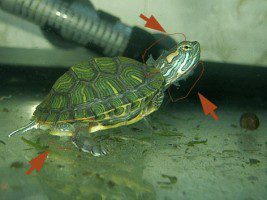
2. In some cases, the process is localized in some parts of the limbs. At the same time, the skin becomes light and seems swollen, pimples or pimples form, the turtle becomes lethargic, sits on dry land for a long time. This is a bacterial infection. The treatment plan is below.

3. Redness of the skin (large surfaces). Turtles scratch the skin if it is affected by a fungus or infection. Most often it is a fungus, but it is recommended to do an examination. Treatment according to the scheme below.
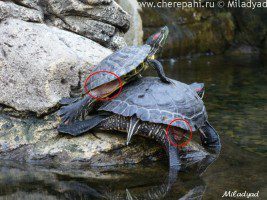
4. In turtles, especially in water turtles, shields partially peel off from the shell. When such a shield is removed, there will be either a piece of a healthy shield under it, or soft corroded material that is picked out. With this dermatitis, ulcers, abscesses and crusts are usually absent. Treatment according to the scheme below. Complete, even and slight detachment of the scutellum, under which there is the same even scutellum, is characteristic of red-eared turtles and is called molting.
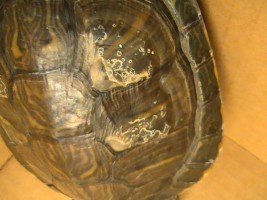
5. In aquatic turtles, the disease usually manifests itself in the form of multiple ulcers, located mainly on the plastron and often passing to the area of soft skin; quite often at the same time there is a blood poisoning. In turtles, there is a noticeable decrease in activity and muscle tone, erasure of the gingival margin and claws, paralysis of the limbs and ulceration of the skin against the background of multiple hemorrhages and dilated vessels. When blood is infected, blood is visible under the plastron shields, wounds, bleeding, as well as general symptoms of anorexia, lethargy and neurological disorders are visible on the mucous membranes of the oral cavity.
Trionics have bleeding ulcers on the plastron, the lower part of the paws, and the neck. The disease is also called “red leg”. Specific for all freshwater turtles, semiaquatic and aquatic amphibians kept in terrariums. Bacteria of the genus Beneckea chitinovora destroy red blood cells and they accumulate in the lymph nodes and in the dermis of the skin – thus forming a red ulcer. In advanced cases, the ulcer really begins to bleed. The treatment regimen is described below.
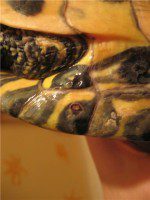
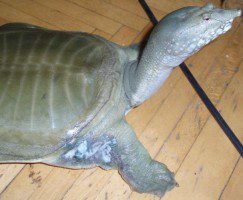
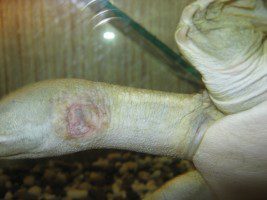
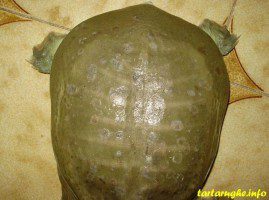
6. Necrosis of the shell. The disease manifests itself in the form of local or extensive foci of erosion, usually in the region of the lateral and posterior plates of the carapace. The affected areas are covered with brown or gray crusts. When the crusts are removed, the lower layers of the keratin substance are exposed, and sometimes even the bone plates. The exposed surface looks inflamed and is quickly covered with drops of punctate hemorrhage. In aquatic species, the process often occurs under the surface of the shield, which dries up, flakes off and rises along the edges. If such a shield is removed, erosion spots covered with brownish crusts are visible under it. The treatment regimen is described below.
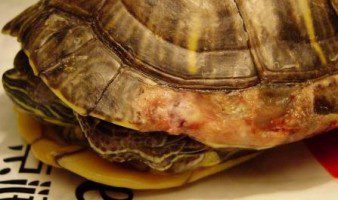
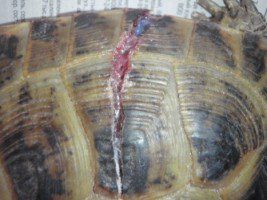
ATTENTION: The treatment regimens on the site can be obsolete! A turtle can have several diseases at once, and many diseases are difficult to diagnose without tests and examination by a veterinarian, therefore, before starting self-treatment, contact a veterinary clinic with a trusted herpetologist veterinarian, or our veterinary consultant on the forum.
Treatment: Treatment is usually long – at least 2-3 weeks, but usually about a month. Strict hygiene of the terrarium and isolation of sick animals is required (especially in case of disease of aquatic turtles). Since a fungal infection usually develops under specific conditions, it is necessary to eliminate the causes that contribute to the infection: improve the diet, increase the temperature, change the humidity, remove the aggressive “neighbor”, change the soil, water, etc. The sick animal is isolated from others. It is advisable to disinfect (boil, treat with alcohol) the terrarium, equipment and soil in it. With this disease, turtles try to constantly sit on the shore. If your turtle does not do this, then the shore that you have equipped for him is not convenient. Stone or driftwood is only suitable for small turtles. Adult heavy animals need to build a spacious platform with an inclined exit from the bottom.
Treatment regimen (item 2)
- Puncture a course of Baytril / Marfloxin
- Bathe the turtle in baths with Betadine. A solution of betadine is poured into a basin in the required proportion, where a turtle is launched for 30-40 minutes. The process must be repeated daily for 2 weeks. Betadine disinfects the skin of turtles.
Treatment regimen (p. 3-4) for the treatment of extensive mycoses (in aquatic turtles – peeling of the skin, redness, detachment of the shields):
- In an aquarium where an aquatic turtle is constantly kept, add 1-2 crystals (until a pale blue color), either the dose indicated on the packaging of the Methylene Blue solution, or similarly, commercial preparations against fungi produced for aquarium fish are used (Antipar, Ichthyophore, Kostapur , Mikapur, Baktopur, etc.). Treatment is carried out within a month. If the filter is carbon, then it is turned off for this time. Charcoal filler kills the effectiveness of the bluing. The bluing itself kills the biofilter. In Antipara, you cannot keep a turtle for more than an hour. The course of treatment is a month. Antipar: Turtles should be transplanted into a jig with warm water (you can use it from the tap). Antipar contribute at the rate of 1 ml per 10 liters of water. The required amount of the drug is dissolved in water and evenly distributed throughout the volume. The course of treatment is 2-3 weeks. Turtle bathing time – 1 hour.
- With severe reddening of the skin, betadine baths can be used. A solution of betadine is poured into a basin in the required proportion, where a turtle is launched for 30-40 minutes. The process must be repeated daily for 2 weeks. Betadine disinfects the skin of turtles.
- At night, it is useful to leave sick freshwater turtles in dry conditions (but not cold!), Treating the affected areas with ointment preparations (Nizoral, Lamisil, Terbinofin, Triderm, Akriderm), and put them back into the aquarium with blue during the day. You can also smear the skin of the turtle with Clotrimazole or Nizoral ointment for half an hour or an hour during the day, then rinse it off with water and put the turtle back into the aquarium. For trionics no more than 2 hours. Another option: creams for the fungus Dermazin and Clotrimazole Akri are mixed in a 1: 1 ratio and smeared on the affected areas 1 time in 2 days. After spreading, the aquatic turtle can be released into the water. The duration of treatment is approximately 2 weeks.
- Vitamin therapy and ultraviolet irradiation sessions are also useful.
- Granulomas, abscesses, fistulas and other infectious areas are treated by a veterinarian. Opened and cleaned.
- To prevent fungal diseases in aquatic turtles, you can use an infusion of oak bark. You can buy an infusion of oak bark at a pharmacy or collect the bark and leaves yourself. Infused for about half a day, until the color of tea. In the presence of a fungus, it is infused to a black color so that the turtles are practically invisible, plus Baytril is pricked. The turtle lives in this water for 1-2 weeks.
Treatment regimen (item 5) especially for soft-bodied turtles in case of fungus:
For treatment you will need:
- methylene blue.
- Betadine (povidone-iodine).
- Baneocin or Solcoseryl
- Lamisil (Terbinofin) or Nizoral
Mytelene blue is added to the aquarium, where the turtle is constantly kept. Every day, the turtle is removed from the water and transferred to a container with a solution of betadine (betadine dissolves in water so that the water acquires a yellowish tint). Bathing time 40 min. Then the turtle is transferred to land. Baneocin is mixed with Lamisil in a ratio of 50 to 50. The resulting mixture is applied in a thin layer on the carapace, flippers and neck. The turtle must be on dry land for 40 minutes. After the procedure, the turtle returns to the main aquarium. The procedure is repeated for 10 days.
Treatment regimen (item 5) for soft-bodied turtles in case of bacterial infection:
- Course of antibiotic Marfloxin 2% (in extreme cases, Baytril)
- Smear the affected areas with Baneocin and keep the turtle on dry land for 15 minutes after the procedures.
Treatment regimen (item 6) treatment method in case of necrosis:
The disease is very serious, so we advise you to contact a veterinarian-herpetologist.
Important conditions for recovery are the creation of absolutely dry conditions (including for aquatic turtles), an increase in daily temperatures and strict disinfection of the terrarium, soil, and in the aquaterrarium – all equipment. The aquarium and equipment must be boiled, or treated with alcohol or a disinfectant solution.
Treatment regimen for the turtle itself: keep the turtle on dry land for 2 weeks. Remove necrotic plates and scutes to prevent the spread of infection. Once every 1 days, smear the entire turtle (both shell and skin) with an antifungal ointment (for example, Nizoral, which is more powerful than Clotrimazole), and in the interval between the ointment, make a chlorhexidine compress for 3 days (cotton moistened with chlorhexidine is covered with a piece of polyethylene and this compress is sealed plaster It can be left on for 2 days, wetting with chlorhexidine as it dries through a syringe).
The turtle may also need a course of antibiotics, vitamins, and some other drugs.
In the event that the turtle’s shells are bleeding, or the mouth or nose is bleeding, it is necessary to give ascorbic acid (vitamin C) daily, as well as to prick Dicinon (0,5 ml / 1 kg of the turtle once every other day), which helps to stop bleeding and strengthens the walls of blood vessels.





